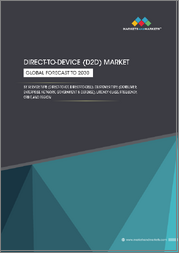
|
시장보고서
상품코드
1620281
아시아태평양 저궤도(LEO)로부터의 위성 D2D(Direct-to-Device) 시장의 성장 기회, 예측(-2029년)Growth Opportunities in Satellite Direct-to-Device from Low Earth Orbit Market, Asia-Pacific, Forecast to 2029 |
||||||
시장이 새로운 차원에 돌입하먀, 수익화 가능성이 변혁적 성장을 달성
아시아태평양(APAC) 저궤도(LEO)로부터의 위성 D2D(Direct-to-Device)의 매출은 2024년 10만 달러에서 2029년에는 6억 4,680만 달러로, 28.6%의 연평균 성장률로 증가합니다(2025-2029년). 접속 서비스가 주로 위성 D2D의 매출을 촉진합니다. APAC는 지역적 특성과 주요인프라에 광범위한 피해를 입힐 수 있는 자연재해에 대한 취약성으로 인해 중요한 시장이 될 것입니다. 광활한 영토와 수천 개의 섬이 있는 이 지역은 인구의 약 55%가 인터넷에 접속할 수 없는 지역입니다.
LEO의 위성 D2D는 위성 연결의 경쟁 수준을 높이고 기본 서비스의 경제성 문제를 해결합니다. 지상 통신사에 의존하는 모바일 서비스의 백업과 보완이라는 두 가지 가능성을 고려하고 있습니다. 소비자와 기업이 어디에 있든, 특히 비상시에 안정적으로 연결될 수 있다는 것은 위험을 줄이고, 소비자의 불편을 줄이며, 지역 기업의 다운타임을 줄이는 형태로 이익을 가져다 줄 것입니다.
위성 프로바이더들은 대부분 이동통신 사업자와 제휴를 맺고 지상파의 접근 방식과 관행을 파괴하려고 노력하고 있습니다. 그러나 매출 창출과 비즈니스 사례를 정당화하는 것은 어려운 과제입니다. 많은 시험이 이루어질 것이지만, 2030년까지 많은 상업적으로 실행 가능한 서비스가 대중 시장에 제공될 가능성은 낮으며, LEO 네트워크 및 장비에서 다양한 위성 D2D로의 상호 운용성과 확장성을 보장하기 위해서는 주파수 및 규제 정책, 생태계 개발, 표준화 노력의 세계 조화 표준화 노력의 세계 조화가 필수적입니다. 개방형 솔루션에 대한 강력한 파트너십은 더 큰 성장 잠재력을 가지고 있습니다.
목차
위성 D2D 분야의 변혁
- 왜 성장이 어려워지고 있는가?
- The Strategic Imperative 8(TM)
- 위성 D2D 업계에서 3대 전략의 영향
에코시스템
- 분석 범위
- 세분화
- 경쟁 환경
- 주요 경쟁사와 개요
성장요인
- 성장 지표
- 성장 촉진요인
- 성장 억제요인
- 예측에 관한 인사이트
- 매출 예측
- 제품별 매출 예측
- 매출 예측 분석
- 가격 동향
- 시장 성장 실현 요인 : 상업 및 규제
- 시장 성장 실현 요인 : 기술
성장요인 : SOS 서비스
- 성장 지표
- 매출 예측
- 예측 분석
성장 제너레이터 : 접속 서비스
- 성장 지표
- 매출 예측
- 예측 분석
성장 제너레이터 : 백홀 서비스
- 성장 지표
- 매출 예측
- 예측 분석
성장 기회 영역
- 성장 기회 1 : 위성 프로바이더용 LEO로부터의 위성 솔루션
- 성장 기회 2 : 이동통신 사업자와 기업용 위성 기반 홀세일 백홀 서비스
- 성장 기회 3 : 모바일 사업자의 수익화 기회의 확대
부록과 다음 스텝
- 성장 기회의 이점과 영향
- 다음 스텝
- 별지 리스트
- 면책사항
Monetization Potential is Experiencing Transformational Growth as the Market Enters a New Dimension
The satellite direct-to-device (D2D) from low Earth orbit (LEO) revenue in Asia-Pacific (APAC) will increase from $0.1 million in 2024 to $646.8 million in 2029 at a 28.6% compound annual growth rate (2025-2029). Connectivity services will mainly drive satellite D2D revenue. APAC will be a key market due to its combination of geography and vulnerability to natural disasters that can cause widespread damage to critical infrastructure. In this region, which has countries with large land masses and thousands of islands, approximately 55% of the population remains without internet connectivity.
Satellite D2D from LEO will increase the competition level for satellite connectivity and address issues related to the affordability of basic services. Two possibilities are being investigated: as a backup and as a complementary to terrestrial carrier-dependent mobile services. The certainty of connecting consumers and enterprises wherever they are, especially in an emergency, will bring benefits in the form of reduced risks, less inconvenience for consumers, and less downtime for enterprises in the region.
Satellite providers, many in partnerships with mobile operators, are out to disrupt terrestrial approaches and practices. However, monetization and business case justification will be challenging. While there will be many trials, it is unlikely that many commercially viable services will serve the mass market before 2030. Global harmonization of spectrum and regulatory policy, ecosystem development, and standardization efforts will be crucial in ensuring interoperability and scalability across different satellite D2D from LEO networks and devices. Strong partnerships working on open solutions will have greater growth potential.
Table of Contents
Transformation in the Satellite Direct-to-device Sector
- Why Is It Increasingly Difficult to Grow?
- The Strategic Imperative 8™
- The Impact of the Top 3 Strategic Imperatives on the Satellite Direct-to-device Industry
Ecosystem
- Scope of Analysis
- Segmentation
- Competitive Environment
- Key Competitors and Profiles
Growth Generator
- Growth Metrics
- Growth Drivers
- Growth Restraints
- Forecast Considerations
- Revenue Forecast
- Revenue Forecast by Product
- Revenue Forecast Analysis
- Pricing Trends
- Enablers of Market Growth: Commercial and Regulatory
- Enablers of Market Growth: Technical
Growth Generator: SOS Services
- Growth Metrics
- Revenue Forecast
- Forecast Analysis
Growth Generator: Connectivity Services
- Growth Metrics
- Revenue Forecast
- Forecast Analysis
Growth Generator: Backhaul Services
- Growth Metrics
- Revenue Forecast
- Forecast Analysis
Growth Opportunity Universe
- Growth Opportunity 1: Satellite Solutions from LEO for Satellite Providers
- Growth Opportunity 2: Satellite-based Wholesale Backhaul Services for Mobile Operators and Enterprises
- Growth Opportunity 3: Broadening Monetization Opportunities for Mobile Operators
Appendix & Next Steps
- Benefits and Impacts of Growth Opportunities
- Next Steps
- List of Exhibits
- Legal Disclaimer



















